|
Evil
madman
or
misunderstood
general?
|
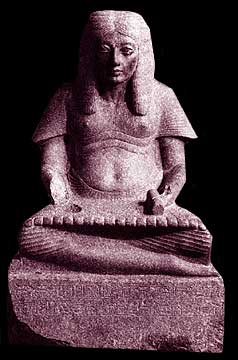 |
Much has been written
about Horemheb, most of it in a very negative way. In the majority
of theories about the end of the Amarna period Horemheb is cast
as the evil general who disposes of any pharaoh and commoner
who stands in his way to becoming pharaoh himself.
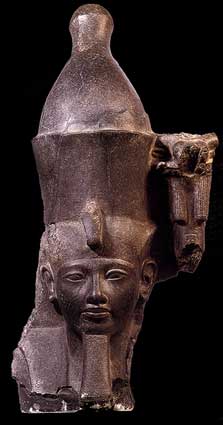 |
Firstly - Who
was Horemheb?
From
the tatters of a failed monotheistic religion the general Horemheb
surfaces to help take control of the country (along with Ay)
and steer Tutankhamun back from the brink of a heretic life of
Aten worship and once more into the arms of Amun.
Horemheb
must of begun his rise in the military during the time of Akhenaten,
when he was known as 'Great Commander of the Army'. But little
is heard about Horemheb during the Amarna Period which has been
taken to mean by some modern scholars to mean that Horemheb was
not prepared to follow the 'mad' teachings of that pharaoh and
/ or was a religious follower of the older gods.
There
is a theory, however, that Horemheb was around in Amarna during
the religious revolution and indeed played a bigger part in it
than previously thought.There is mention of someone known as
Paatenemheb, who may or may not be Horemheb. Why the connection?
Horemheb does seem to spring into existence under Tutankhamun,
and in a powerful position. Could Paatenmheb and Horemheb be
the same man? Paatenmheb was a follower of the Aten, he was at
Amarna and was a powerful man during that time.
When
the Aten religion crumbled did Paatenmheb rather shrewdly change
his religion back to the glorious Amun and change his name from
the heretical PaATENmheb to Horemheb?
|
To add strength to his
position (politically and in terms of his chances of reaching
the throne), Horemheb was married to Nefertiti's sister Mutnedjmet. - To read more about her, and his mysterious first wife - CLICK HERE
Horemheb's Memphite
tomb.
Before he became Pharaoh,
Horemheb started work on his tomb at Saqqara. Not only do many
images of Horemheb come from here (showing how the uraeus was
added to his brow after the original carving took place), but
also a list of his titles he had while serving under Tutankhamun:
|
Concerning the
Pharaoh and Central Government Hereditary:
Prince
(of Upper and Lower Egypt) and count.
Sole
Companion.
Deputy
(Regent) of the King in the entire land.
Foremost
of the King's courtiers.
Fanbearer
on the right of the king.
Master
of the Secrets of the Palace.
Overseer
of (all) Offices of the King.
One elected
by the King above the Two Lands to carry out the government of
the Two Banks.
Military:
Overseer
of the Generals of the Lord of the Two Lands.
Generalissmo.
King's
Envoy.
Scribe
of Recruits.
Overseer
of Recruits of the Lord of the Two Lands.
|
General Administration:
Chief
of the Entire Land.
Seal
Bearer of King of Upper and Lower Egypt.
High
Steward.
Mouth
Who Appears in the Entire Land.
Scribal:
True
Royal Scribe.
One Who
has authority over the library.
Overseer
of all Overseers of Scribes of the King.
Public
Works:
Overseer
of all works of the King in every place.
Overseer
of works in the hill of gritstone.
Religious:
Overseer
of all divine Offices.
Overseer
of Priests of Horus, lord of Seby.
|
(These
are only some of the titles in his tomb!)
Horemheb's rebuilding
program
Horemheb wasted no time
in undertaking numerous building projects when he succeeded Ay
as pharaoh (these included work at the temples of Karnak (the
Great Hypostyle Hall) and Luxor), this also meant repairing the
various temples that had been shut down and neglected during
Akhenaten's time in power. Horemheb also took over many monuments
belonging to Tutankhamun and Ay.
Horemheb also began to
rebuild law and order (especially in local government) which
had apparently flourished under Akhenaten - the Pharaoh instituted
law-courts in all the major cities (he then appointed priests
from the local temples and mayors from the towns as judges in
his law-courts and made them directly responsible to him).
Horemheb and the desecration
of Akhenaten.
It is not very clear
as to what extent Horemheb took in destroying the name of Akhenaten
and his immediate family; it is thought that he may have given
the orders to raze Amarna to the ground, desecrate the Royal
Tomb at Amarna and also to dismantle the Aten temples at Thebes
(surviving until present day and now known as 'Talatat'). However,
it is also thought that the later Ramesside Kings may have taken
it upon themselves to add to this process. But if Horemheb was
responsible for entering Ay's tomb in the valley of the Kings
to exact religious retribution (which is a serious act) then
it would suggest that Horemheb was following a plan of 'divine
justice' and if not responsible for all the destruction of the
works of Akhenaten then he must of been responsible for at least
a good amount.
Tomb KV57 - tomb of Horemheb
in the Valley of the Kings
Horemheb's tomb was a
change from the type of tomb that had been built before, both
in its design and its decoration (on its walls were scenes from
the Book of Gates (a religious text along the same lines of the
Book of the Dead).
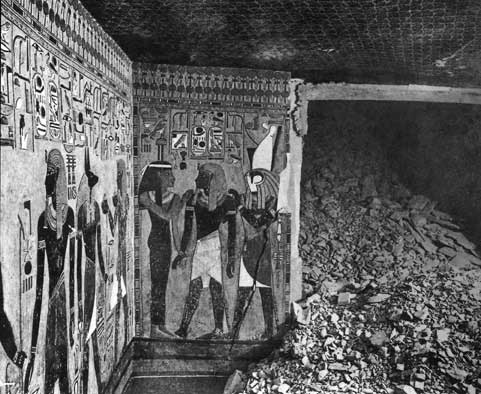 Decoration in
the tomb
Decoration in
the tomb
|
Room
E (Well Room)
(1)Left half of the room.
Five scenes:
1. Anubis Jackal
2. King led by Harsiesi
to Isis
3. Offering wine to Western
Hathor.
4. Before Osiris-Onnophris.
5. Before Western goddess
and Harsiesi
(2) Right half of the
room. Five scenes:
1. King led by Horus
to Hathor.
2 - 4. as at (1).
5. King before Osiris,
Anubis and Harsiesi.
|
Antechamber
I
(3)Left half of room.
Seven scenes:
1. King embraced by Hathor.
2. Before Anubis.
3. Offering wine to Isis.
4. Before Harsiesi.
5. Offering wine to Hathor.
6. Before Osiris.
7. Offering ointment
to Ptah in front of a Zad-pillar.
(4)Right half of room.
Seven scenes.
1. King led by Harsiesi
to Hathor.
2. Offering wine to Anubis
3. Before Isis.
4. Offering wine to Harsiesi.
5. Before Hathor.
6. Offering wine to Osiris.
7. Before Nefertem in
front of sa-sign.
|
|
Sarcophagus
Chamber J (Golden Hall)
(5) Outer thicknesses,
Ma'at.
(6) and (7) Book of Gates,
1st division.
(8) and (9) Book of Gates,
3rd and 4th divisions, three registers, I-III, and part of 5th
division.
(10) and (11) Book of
Gates, 2nd division.
(12) Book of Gates, 5th
division with Hall of Osiris.
Sarcophagus, red granite,
still in tomb.
|
Side-room
K
(13) Osiris in front
of zad-pillar (painted).
|
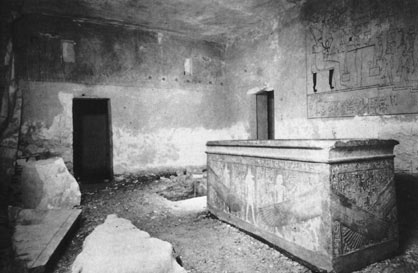
|
Horemheb's tomb was discovered
in 1907/08 by Theodore Davis, the decorations in the tomb were
still in very good condition - although some of the columns and
walls in the tomb were cracked and loose (caused by the movement
of the hillside itself above the tomb). The original stone chippings
dating back to when the tomb was first dug out from the hill
still filled the tomb seeming like drifts of sand. Bones were
found in the tomb, some still in the sarcophagus but others had
been thrown into other rooms. The mummies belonging to Horemheb
and his queen had not been recovered in the cache of kings and
so it seems likely that these pathetic remains are all that is
left of this particular pharaoh and his queen (although there
some inspection graffiti on a door jamb within the tomb that
can cast a little uncertainty on this assumption). If a correct
and proper excavation had been undertaken then perhaps more questions
could of been answered, but Davis and his team were true to form
(KV55 a good example) and now a lot of evidence has been lost.
Horemheb's
burial equipment had been shattered, broken, stripped and scattered
throughout the tomb.
The tomb
does show much evidence that the original tomb builders were
not able to finish before the burial of Horemheb - the reliefs
on the different walls show different stages of completion. Some
scenes have only been sketched in by the intial draughtsmen,
some then have correcting marks made on these intial sketches
followed again by the first steps of carving the figures into
the walls. Most of the tomb does lack any decoration - most of
the corridors are painted a plain white.
|
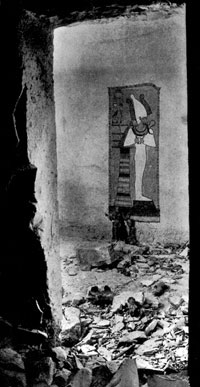 |
The sarcophagus and the
Book of Gates.
Horemheb's sarcophagus
was a similar design to that of Ay's, Tutankhamun's and Akhenaten's
- a very grand affair with a goddess supporting the corners.
The Book of Gates, which
shows the specific problems of the Beyond - the threat of Apophis,
the nature of time, Justice, material blessings and composition
of the Beyond
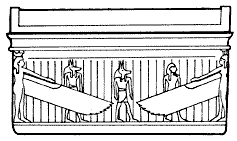
Monuments of Horemheb
|
Memphis
- Tomb before accession
Memphis - Apis burials,
Serapeum
Memphis - Piece of stela
Amarna - Fragment in
Aten temple
Karnak - Pylon X
Karnak - Pylon XI
Karnak - Connecting wall
of pylons
Karnak - Avenue of sphinxes
|
Karnak
- Wall between Pylon V and sanctuary
Karnak - Stele
Karnak - Inscription
in temple of Ptah
Karnak - Block in pylon
of Khonsu temple
Luxor - Usurped colonnade
Deir el Bahri - Restoration
inscription
|
Medinet Habu - Restoration
inscription
Silsileh - Rock temple,
scenes of gods
Silsileh - Rock temple,
Sudan war
Kom Ombo - Block re-used
by Ptolemies
Kuban - Lion-Headed Shrine
Gebel Addeh - Rock shrine
|
|







